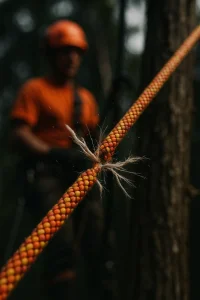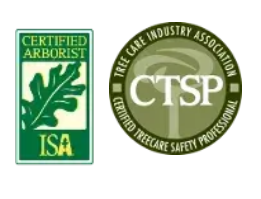Avoiding Tree Work Accidents: Lessons from the Field
Tree care is one of the most dangerous jobs out there—I’ve seen it firsthand over the years. Whether you’re a seasoned arborist or just starting out, working at heights with heavy equipment and unpredictable tree limbs is always risky. But here’s the truth: most of these risks are preventable if you commit to proper safety practices.
From my years in the field, I can tell you that understanding common accidents, their causes, and how to avoid them could literally save your life. Let’s go through some of the most common hazards and what you can do to stay safe.
Common Tree Care Accidents—and How They Happen
Tree work is no joke. It combines climbing, cutting, and managing massive natural structures. Here are some of the biggest risks I’ve seen, along with why they happen:
1. Falls from Heights
Falls are the number one cause of serious injuries and fatalities. It usually comes down to climbing without proper gear, anchor mistakes, or branches giving out unexpectedly. In fact, the Tree Care Industry Association (TCIA) found that falls caused 43% of tree care fatalities last year.
2. Chainsaw Injuries
Chainsaws are powerful but unforgiving. Improper handling, kickbacks, and using them in tight spaces lead to thousands of injuries a year. I’ve seen injuries that could’ve been avoided just by taking a second to check positioning or wearing proper PPE.
3. Struck-by Incidents
This one’s common. Misjudging the weight of a branch, not evaluating tree structure, or even dropping tools can lead to severe “struck-by” injuries. Trust me—failing to plan where a branch will fall is a mistake you only make once.
4. Equipment Failures
I’ve seen gear that’s been pushed far beyond its limits. Broken ropes, worn-out carabiners, or gear that hasn’t been maintained can lead to catastrophic accidents. Regular inspections and not cutting corners on equipment upkeep are non-negotiable.
5. Electrocution
Power lines are a silent threat. When trees touch live wires, they can conduct electricity, creating deadly situations in a split second. Always assume the lines are live and keep your distance.
6. Environmental Factors
Unstable ground, bad weather, or even wildlife like bees and wasps can make tree work unpredictable. Sudden gusts of wind or slippery conditions can knock you off balance or topple a ladder.
Safety Tips I Swear By
Here’s how you can avoid being another statistic. These tips are hard-earned, and I always pass them on to anyone I work with:
1. Get Proper Training and Stay Certified
Safety starts with education. Training through organizations like the International Society of Arboriculture (ISA) or Tree Care Industry Association (TCIA) is essential. These programs teach skills that could save your life, from climbing techniques to chainsaw operation. Never stop learning.
2. Gear Up Right
Your gear is your lifeline—literally. Make sure you have:
High-quality climbing ropes, harnesses, and carabiners rated for tree work.
PPE, including helmets, gloves, eye protection, cut-resistant pants, and sturdy boots.
Well-maintained tools. Always inspect and sharpen your chainsaws.
3. Do a Site Walkthrough Before Every Job
Before you make a single cut, take time to assess the site:
Look for weak branches, decay, or anything structurally unstable.
Check for power lines and keep a safe distance.
Ensure the ground is stable, especially if using ladders or machinery.
4. Communicate Clearly
Good communication can prevent accidents. Use radios or hand signals to stay in sync with your crew. Make sure everyone knows their role before you start—and don’t assume everyone’s on the same page.
5. Have Emergency Plans in Place
Accidents happen, even with the best preparation. Always keep a first-aid kit handy and have a plan for injuries, gear failure, or other emergencies. Make sure everyone knows what to do in a worst-case scenario.
6. Follow Industry Standards
The ANSI Z133 standards for tree care operations exist for a reason. They’re the gold standard for safety in our industry. Stick to them, and you’ll avoid a lot of unnecessary risks.
Learn from Real Accidents
Let me share two stories I’ve encountered to highlight why safety is so critical:
Case Study 1: Worn-Out Climbing Rope
An arborist I knew fell 25 feet after an old rope snapped during a cut. He skipped regular inspections, and the rope had deteriorated over time. Lesson: Inspect your gear before every job, and replace it when it’s past its prime.
Case Study 2: Chainsaw Kickback
A worker I trained once had a nasty kickback injury when cutting an overhead branch. He didn’t position himself properly, and the chainsaw tip caught the wood. Lesson: Always position your chainsaw carefully and wear your PPE—it’s your last line of defense.
Building a Safety-First Tree Care Culture
At the end of the day, safety is about more than just avoiding accidents—it’s about making sure everyone on your team goes home at the end of the day. By investing in training, using the right equipment, and following best practices, you can create a culture where safety comes first.
If you’re looking for expert advice or resources to improve safety in your tree care work, reach out to professionals like Tip Top Arborists. Let’s work together to build a safer, stronger industry—because no job is worth risking your life.
Stay safe out there!

Never Start a Cut Without a Mental Exit Plan. Before every cut—whether it’s on the ground or 40 feet in the air—pause and ask yourself: “If this branch shifts or kicks, where do I go?” Always keep a clear path of retreat and avoid boxing yourself into corners or tight spots. One extra second of planning can save your back, your saw, or your life.
FREQUENTLY ASKED QUESTIONS
Why is tree care considered so dangerous?
Tree work involves heights, chainsaws, falling limbs, and unpredictable conditions. Without proper gear and training, the risk of serious injury is high.
What safety certifications should tree care professionals have?
Look for certification from the International Society of Arboriculture (ISA) or Tree Care Industry Association (TCIA). These ensure the worker is trained in safe, standardized practices.
What kind of gear should professional arborists use?
They should have climbing harnesses, ropes rated for tree work, helmets, gloves, chainsaw pants, boots, and well-maintained cutting tools.
How can homeowners prepare their property before tree work begins?
Clear the area of vehicles, furniture, and pets. Let the arborist walk the site to identify any risks like power lines, unstable trees, or poor footing.
Climb Higher. Cut Smarter. Trust Tip Top
At Tip Top, we don’t just work in trees — we live for them. This is a crew built for climbers, cutters, and canopy junkies who take pride in precision, thrive on challenge, and never back down from a tough takedown. We’re fearless in the field, sharp with our gear, and dead serious about safety, skill, and getting the job done right. If you know your knots, love your rig, and believe tree work is more than a job — it’s a craft — you’ll fit right in.


